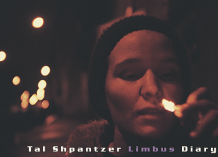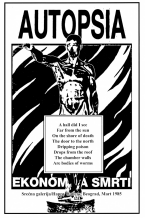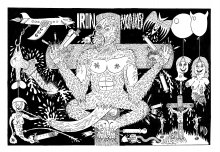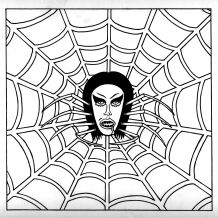| Zeitschrift Umělec 2001/1 >> Marginal Differences | Übersicht aller Ausgaben | ||||||||||||
|
|||||||||||||
Marginal DifferencesZeitschrift Umělec 2001/101.01.2001 Lenka Lindaurová | q & a | en cs |
|||||||||||||
|
"Michal Koleček established himself in the 1990s as a unique curator for the Emil Filla Gallery in Ústí nad Labem, CZ. As a result of his efforts, many artists from the former Eastern Bloc are not only finding a place in Ústí, but also in Prague.
In your work as a curator you mostly focus, as few here do, on post-communist art. How did you first become interested in something so specific? First, I’d like to make something clear. My focus is a little narrower than the question implies. The term “post-communist art” is very broad, and it’s not possible for an individual to process it in a deeper way. I am interested in contemporary art that is being made in the Central European, post-communist environment, meaning mostly Bosnia and Herzegovina, Croatia, Hungary, Poland, Slovakia, and Slovenia. I can name several reasons why. The two years of work I put in on the board of the Soros Center for Contemporary Art in Prague was a strong impetus. That’s where I made several contacts and familiarized myself with the cultural situation in these countries, as well as the situation on individual art scenes. Another impetus is the basic inter-relatedness of the artistic testimonies being formed in the Central European region. Clearly the countries of this region share a lot, both in history and in the recent past. They are connected by their experiences with the Austro-Hungarian monarchy, different totalitarian regimes and, more recently, by the process of political and social transformation. And through the confrontation of artistic standpoints I am interested in pointing out what we have in common or how we differ. I should also mention my fascination with the situation on the fringes, for the Central European area has a distinct, peripheral character on a political, economic and cultural level. Moreover, while researching this environment I try to go deeper below the surface to find strong individual positions or movements outside of the main cultural centers. Do you think that art from the “East” has something unique, some distinction that makes it different from Western art? You can probably find some shared foundation for Central European, post-communist visual art. However, this relatedness is not very visible; it’s not apparent on a formal level. Central European artists take total advantage of the possibilities of contemporary visual language, and their works in terms of technological and communication strategies are fully compatible with the world’s artistic trends. What is specific exists the content of the artistic testimony — meaning the message that is hidden in the work, the source of which is the shared general and cultural history, as well as the contemporary social and political situation in this region. The events that took place during the past few decades, the communist regimes and their fall, social transformation, national conflicts and so on, have distinctly moved each one of us, and artists have either unconsciously or consciously reacted to them in their work. Isn’t the term “Central European tradition” more of a cover up for the fact that this art has not been included within the Western context? I don’t think that the term “Central European tradition” is only an effective argument used to get something out of the art market. Besides, Austria and a large area of Germany, which form a natural part of the so-called Western context, belong in the Central European cultural environment. From a historical standpoint certain analogies of the Central Europe phenomenon can be found among the Scandinavian countries, the Baltic or the Benelux regions. All of these examples are multinational regions that are connected by many long-term political, economic and cultural ties. In this day and age, which is on the one hand characterized by globalization and on the other hand by the fragmentation of social views, regionalism can be an important and even successful topic. It should be emphasized that another interest of mine besides the issue of Central Europeanism is connected to transformational, post-communist processes. But even in this context we cannot talk about a clear-cut strategy directed at placing specific authors or trends into a wider context. These transformational specifications are far more deeply rooted in the political and social situation of each individual, rather than in an actual art undertaking. Do you think that the next generation of artists, who never lived under a totalitarian regime, will have a different artistic testimony? The testimony of the next generation of artists will certainly be different, for each generation reacts to specific issues, specific situations and events. After all, even our age group does not deal with the theme of totality, immutability, in great detail. Instead we deal with the phenomenon of transformation, or movement and inconstancy, that, besides the local political connotations, is obviously associated with the feeling of crossing over into a new millennium or using new communication technologies. We can only hope that we will be able to orient ourselves sufficiently in future social and cultural processes and that we will be able to decode their visual codes. Is it your opinion that local and Eastern art is political (apolitical) and why is this so? Contemporary Central European, post-communist visual art is not in my opinion any more or less political than art from other parts of the world. Certainly the development of political processes is reflected in it, sometimes quite vividly, other times less noticeably, almost subliminally. But it seems that a wider social element is strongly present in the Central European context. (It is necessary to differentiate here, for social issues cannot be boiled down simply to the arena of politics.) Central European, post-communist art exists in a certain economic, cultural, and institutional vacuum, and it is poignantly aware of this ungroundedness, even isolation. Its social position and self-confidence are not nearly as strong as is the position of so-called “Western” art. Instead it offers a greater level of authenticity and personal passion. Contemporary Central European, post-communist artists continually analyze the essence of their artistic views; they think through the social status of an artistic work, and they link this research to specific social processes. Could you be more specific and explain this tendency with some examples? When the Croatian artist Slaven Tolj was preparing an independent exhibition for the Malá Špálovka Gallery in Prague in 1999, he chose as his topic for the project an ad campaign that was at the time tempting Czech citizens to take a holiday in Croatia. He ruthlessly contrasted the advertising image with the everyday situation in his own country, which is painfully trying to deal with the consequences of the Balkan wars. The artist only used a few tools to build up the tension that ultimately filled the small exposition. From his hometown, Dalmatian Dubrovnik, he brought back to Prague an illuminated sign from one of the local restaurants and his own table lamp. To these he simply added a broken old television. The work is called So Beautiful, So Empty, and in fact Tolj’s whole creative strategy is based on the principles of careful, analytical reflection and an intimate co-experience of surrounding reality. We can find a similar atmosphere in the works of several other Central European, post-communist artists such as Pawel Althamer (PL), Attila Csörgö (HU), Michal Kalhous (CZ), Antal Lakner (HU), Markéta Othová (CZ), Roman Ondák (SK) and Tomo Savić-Gecan (HR). Is it hard to work in one region, and what’s the point of doing so? I’ve been helping to form the concept of the Emil Filla Gallery for almost ten years now, but I don’t feel that my activities are limited in any way. It should be stated that there are generally suitable conditions for cultural activities in Ústí nad Labem. The town is the region’s center, it has a university with an art faculty, and it is in a good location as it is situated on the Berlin-Prague-Vienna communication line. Moreover, we are trying to secure the necessary standard in the organization of exhibition projects. We often invite guest curators. We support artists with financial contributions for their catalogues; basically, using the objective possibilities at our disposal, we want to be professional. The gallery and even Ústí nad Labem thus have something to offer, and this allows us to build up a whole range of international contacts alongside local activities. Rather than feeling like we’re on the periphery, under the given circumstances it is important to me that the work I do for a non-state and non-commercial gallery allows me to be independent in the art field. Economics is a different matter entirely, but here we come upon deeper problems in conducting visual art, with its infrastructure and its position in contemporary society. Still, there’s always more flexibility in independent organizations than in state or town museums with their overgrown and ineffective apparatuses. Do you perceive your work as educational or do you have your own personal ambitions? I mostly work as a curator; that is, I conceive and organize exhibitions of contemporary art. This activity basically focuses on the process of communication, which is (or should be) conducted on several levels. It consists of a dialogue between the audience and the artwork, between the curator and artist, amongst individual artifacts or authors (at group exhibitions), between the artwork and a specific exhibition space, between different interpretations of artifacts, and so on. If this kind of communication is to make any kind of sense then it must be completely open and it can’t stagnate. It’s not possible to focus only on one group of artists, the same artifacts, one audience, or always the same gallery space. In this sense, I believe that my activities penetrate certain local educational ambitions which are connected to specific projects. I move quite freely among several Czech and foreign institutions, some of which could be considered prestigious, but this doesn’t make me want to leave the periphery (Ústí nad Labem). Would you like to have your own private gallery? I haven’t really seriously considered opening a private, commercial gallery. The reasons for this are very much the same as why I am not interested in permanently joining an official organization. I don’t see a big difference between the pressure of institutional bureaucracy and the pressure of the art market. Furthermore, my ability in the area of financial strategy, the promotion of artists and even dealing with potential buyers is questionable. All in all, I’m happy in the non-governmental and nonprofit sector, although I admit that my income can be frustrating. Your wife is an artist. Are you detached enough not to give her favor? Are you her curator? Trying to keep a critical view of the work of someone as close as a wife or husband can sometimes be a problem. On the other hand, it is necessary to point out that in our situation (a young family with two children) art is not a frequent topic of conversation, because we’re constantly trying to deal with other, completely non-poetic matters. The last time I curated an independent exhibition for Zdena was at the Filla Gallery in 1994, though sometimes I collaborate with her on group projects within the Ústí circle. Specific artifacts are more important to me during the preparation of each exhibition than the names of artists. So I wouldn’t say there is any favoritism (towards my wife or any other person) in this context. If I had to name something that might be an advantage for Zdena, then it would be the contacts I make as a result of my activities abroad. What do you think is our position on the art scene in relation to other post-communist countries? When I discuss this issue with artists or curators from other countries then I usually hear criticism of their own positions and admiration for the art situation in the Czech Republic. The truth of the matter is that since the beginning of the 1990s the local art scene has looked with disdain on any cooperation between post-communist countries. This is undoubtedly a result of [former Prime Minister] Klaus’ opinion concerning our economic and cultural exclusiveness within a transforming Central Europe. Unfortunately this opinion has been accepted by a large part of the political spectrum and even by the increasingly frustrated public. As a result of the one-sided and less than successful orientation towards “Western art,” the Czech art scene has gradually closed up. This trend is in direct conflict with a distinct movement towards the cultural integration of the Central European region, which manifests itself in intensive bilateral relations and a shared assertion of art production outside of the region. If we look back at the important exhibitions that integrated contemporary post-communist art into the international context, we will see that the Czech art scene was absent or was only schematically represented, without a deeper context. This is not surprising considering the very small number of projects devoted to surrounding art scenes that were organized by Czech institutions during the 1990s, and likewise the number of foreign presentations of local art they participated in. It is also important to keep in mind that this isolation does not only concern the actual artists, but also the curators and other participants in the art scene, who have a hard time placing themselves in a wider context, even if it’s only Central European, due to the focus on the Czech environment. What is the contemporary Czech art scene missing? I think that the answer to this question is directly related to what was already said about the position of contemporary Czech art within the Central European, post-communist environment. The problem is not really a lack of exhibition opportunities, artists, audiences or money. The local environment mainly lacks a greater openness and professionalism, and, related to this, a willingness to communicate, to compete in a positive way, to continually express one’s views. What was the last good exhibition you saw in the Czech Republic, and why did you like it? It’s a good sign that I don’t have to look back too far. At the moment there are two projects taking place in Prague that are certainly worth seeing. In the Jiří Švestka Gallery Lukáš Jasanský & Martin Polák are presenting black and white photos from the cycle Municipal Exhibition of Photography; and the intermedia artist Pavel Kopřiva has prepared several objects and installations for the Romanesque basement of the Czech Museum of Art on Husova Street. At first glance it might not seem as if these exhibitions have anything in common, but on more careful observation you can find an important connection. I mean the attempt at analyzing processes of visual communication and orientation in a contemporary world flooded with a galaxy of information. Jasanský & Polák again surprise us with their ability to grasp simple things, without stylization or effects. Kopřiva on the other hand constructs artworks simulating complex scientific, technical or communication equipment or systems. Both concepts force us to doubt, and this is the principle that the contemporary Czech art scene, and the Czech environment on the whole, painfully lacks. Translated by Lenka Kršiaková Photo: Marko F. Ercegović "
01.01.2001
Empfohlene Artikel
|
|||||||||||||
|
04.02.2020 10:17
Letošní 50. ročník Art Basel přilákal celkem 93 000 návštěvníků a sběratelů z 80 zemí světa. 290 prémiových galerií představilo umělecká díla od počátku 20. století až po současnost. Hlavní sektor přehlídky, tradičně v prvním patře výstavního prostoru, představil 232 předních galerií z celého světa nabízející umění nejvyšší kvality. Veletrh ukázal vzestupný trend prodeje prostřednictvím galerií jak soukromým sbírkám, tak i institucím. Kromě hlavního veletrhu stály za návštěvu i ty přidružené: Volta, Liste a Photo Basel, k tomu doprovodné programy a výstavy v místních institucích, které kvalitou daleko přesahují hranice města tj. Kunsthalle Basel, Kunstmuseum, Tinguely muzeum nebo Fondation Beyeler.
|
































 New book by I.M.Jirous in English at our online bookshop.
New book by I.M.Jirous in English at our online bookshop.
Kommentar
Der Artikel ist bisher nicht kommentiert wordenNeuen Kommentar einfügen